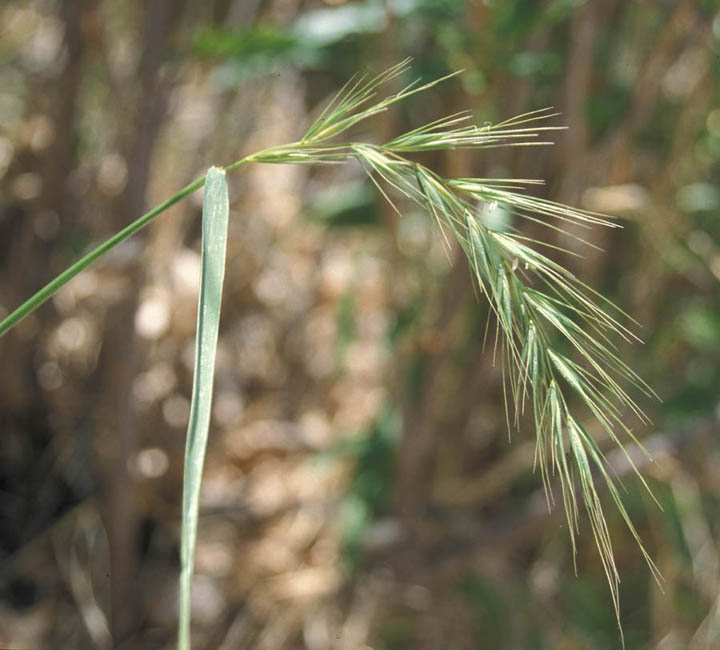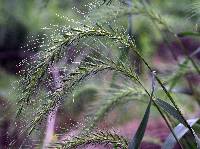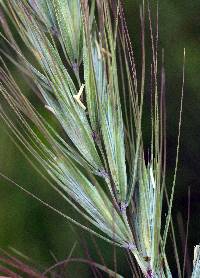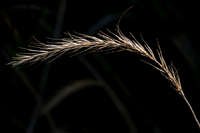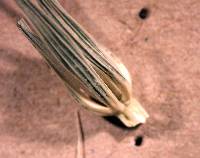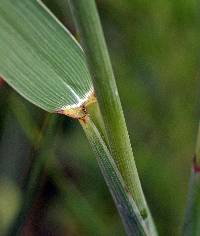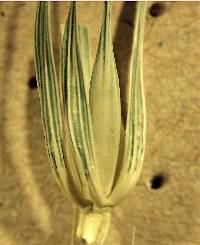- Home
- Search
- Images
- Datasets
- Sample Use
- How to Cite
- Additional Information
- About NEON
- NEON Data Portal
- ASU Biocollections
- About Symbiota
|
|
|
|
Family: Poaceae
Canada wildrye, more...Wiegand's wildrye
[Elymus brachystachys Scribn. & C.R.Ball, moreElymus canadensis subsp. wiegandii (Fernald) Á.Löve, Elymus canadensis var. brachystachys (Scribn. & C.R.Ball) Farw., Elymus canadensis var. hirsutus (Farw.) Dorn, Elymus canadensis var. robustus (Scribn. & J.G.Sm.) Mack. & Bush, Elymus canadensis var. villosus Bates, Elymus canadensis var. wiegandii (Fernald) Bowden, Elymus crescendus (Ramaley) C.F.Wheeler, Elymus philadelphicus L., Elymus philadelphicus var. hirsutus Farw., Elymus robustus Scribn. & J.G.Sm., Elymus wiegandii Fernald] |
Plants loosely cespitose, rarely with rhizomes to 4 cm long and 1-2 mm thick, often glaucous. Culms (40)60-150(180) cm, erect or decumbent; nodes 4-10, mostly concealed by the leaf sheaths, glabrous. Leaves evenly distributed; sheaths smooth or scabridulous, glabrous or hirsute, often reddish brown; auricles 1.5-4 mm, brown or purplish black; ligules to 1(2) mm, truncate, ciliolate; blades (3)4-15(20) mm wide, usually firm, often ascending and somewhat involute, usually dull green, drying to grayish, adaxial surfaces usually smooth or scabridulous and glabrous, rarely sparsely hispid to villous. Spikes 6-30 cm long, 3-7 cm wide, usually nodding, sometimes pendent or almost erect, usually with 2(3) spikelets per node, occasionally to 5 at some nodes, rarely with 1 at some nodes but never throughout; internodes (2)3-5(7) mm long, or 5-10 mm long towards the base, 0.2-0.35 mm thick at the thinnest sections, glabrous or with a few hairs below the spikelets. Spikelets 12-20 mm excluding the awns, more or less divergent, with (2)3-5(7) florets, lowest florets functional; disarticulation usually above the glumes and beneath each floret, rarely also below the glumes. Glumes usually equal, occasionally subequal, 11-40 mm including the awns, the basal 0-1 mm subterete and slightly indurate, glume bodies 6-13 mm long, 0.5-1.6 mm wide, linear-lanceolate to subsetaceous, entire, widening or parallel-sided above the base, 3-5-veined, glabrous to scabrous-ciliate, rarely villous on the veins, margins firm, awns (5)10-25(27) mm, straight to outcurving; lemmas 8-15 mm, glabrous, scabrous, hispid, or uniformly villous with the hairs generally appressed, awns (10)15-40(50) mm, moderately to strongly outcurving, often contorted at the spike bases; paleas 7-13 mm, acute, usually bidentate; anthers 2-3.5 mm. Anthesis May to July. 2n = 28, rarely 42. Elymus canadensis grows on dry to moist or damp, often sandy or gravelly soil on prairies, dunes, stream banks, ditches, roadsides, and disturbed ground, or, especially to the south, in thickets and open woods near streams. It is widespread in most of temperate North America, extending from the southwestern Northwest Territories to Coahuila, Mexico , being especially common in the Great Plains. Reports from California and the southeastern states appear to be based on misidentifications. E. canadensis is considered a good forage species. Elymus canadensis is sometimes confused with E. riparius , from which it differs in having curved rather than straight awns; and with E. wiegandii , from which it differs in its less robust habit and narrower leaves. It can hybridize with Elymus glabriflorus , E. virginicus , E. hystrix -and allies, E. glaucus , E. trachycaulus , Pseudoroegneria spicata , and other species. Subsequent introgression may have contributed to much of the diversity within the genus (Pohl 1959; Brown and Pratt 1960; Nelson and Tyrl 1978; Davies 1980; Campbell 2002). The three varieties recognized here show clear differences in their typical expression and evidence some geographic separation, but they may prove to be artificial reference points within a more or less continuous variation (Sanders et al. 1979). Nevertheless, crossing barriers sometimes exist between the varieties, and even between some sympatric strains (Church 1954, 1958, 1967a). Coarse, 8-15 dm, green or glaucous, in small clumps; lvs mostly 5-9 per stem, firm, flat, 3-12(-15) mm wide, glabrous or scabrous above; auricles 1-2 mm, often clasping the stem; spikes (7-)10-20(-30) cm, usually broadly arcuate or distally nodding, compact above, often loose or interrupted below, the internodes mostly 4-7 mm; spikelets mostly paired, or some of the lower in 3's or even 4's, 12-15 mm, 3-4-fld; glumes subequal, 15-30 mm overall, mostly 0.8-1.5 mm wide, 3-5-veined, broadest above the mostly flat and striate base, tapering into a straight awn usually equaling or longer than the body; lemmas 8.5-14 mm, usually strongly scabrous-hirtellous, 5-7- veined above, gradually tapering into a long, flexuous, spreading, scabrous awn 15-30(-35) mm; larger paleas 8.5-12.5 mm, the tip very acute and usually bidentate; anthers 2.5-4 mm; 2n=28, 42. Streambanks and dry to moist fields and meadows; N.B. and Que. to Alas., s. to N.C., Tex., and Calif. A hybrid with Hordeum jubatum has been called lyhordeum dakotense (Bowden) Bowden. Gleason, Henry A. & Cronquist, Arthur J. 1991. Manual of vascular plants of northeastern United States and adjacent Canada. lxxv + 910 pp. ©The New York Botanical Garden. All rights reserved. Used by permission. FNA 2003, Gould 1980 Common Name: Canada wildrye Duration: Perennial Nativity: Native Lifeform: Graminoid General: Loosely tufted perennial with stems 60-150 cm, erect or decumbent with 4-10 nodes mostly concealed by smooth or minutely roughened sheath, which is often reddish brown, glabrous or hirsute, with auricles 1.5-4 mm. Vegetative: Evenly distributed blades 4-15 mm wide, usually firm, flat, often ascending and somewhat involute, dull green drying to grayish, upper surfaces smooth to minutely roughened or glabrous, ligules 1 mm, truncate and ciliolate. Inflorescence: Spike 6-30 cm long, 3-7 cm wide, nodding, sometimes pendant or erect, usually with 2 spikelets per node, occasionally to 5 at some nodes, internodes 3-5 mm long, glabrous or with a few hairs below spikelets; spikelets 12-20 mm excluding the awns, with 3-5 florets, disarticulation above the glumes and beneath the floret; glumes equal, 11-40 mm, including awns, glume bodies 6-1 mm long, linear lanceolate, entire, 3-5 veined, awns 10-25 mm, straight to outcurving; lemmas 8-15 mm, uniformly villous with hairs generally appressed 15-40 mm strongly outcurving, often contorted at the spike bases. Ecology: Found on dry to moist or damp soils, on sandy or gravelly soils along streams, disturbed grounds, or in thickets and woods near streams from 3,000-9,000 ft (914-2743 m); flowers May-July. Notes: Distinctive with its outcurving awns and the thick spike. Ethnobotany: Used to soak corn in before planting, taken for kidneys, seeds were used for food, and as fodder for livestock. Etymology: Elymus comes form Greek name elymos for millet, while canadensis means of or from Canada. Synonyms: Elymus brachystachys, E. canadensis var. brachystachys, E. canadensis var. hirsutus, E. canadensis var. robustus, E. crescendus, E. philadelphicus, E. philadelphicus var. hirsutus, E. robustus Editor: SBuckley, 2010 |
|
|
|


